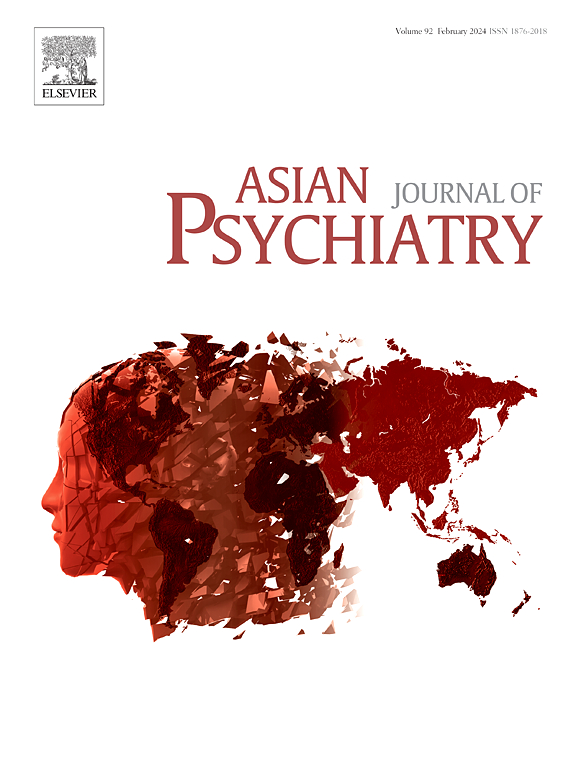Safety and efficacy of early augmentation with Transcranial Direct Current Stimulation (tDCS) in adolescents with Major Depressive Disorder: A randomized controlled trial
IF 3.8
4区 医学
Q1 PSYCHIATRY
引用次数: 0
Abstract
Background
Transcranial Direct Current Stimulation (tDCS) is an emerging modality with demonstrated efficacy in Major Depressive Disorder (MDD), however, there is paucity of research in adolescent depression. This study attempts to evaluate the safety and efficacy of tDCS in adolescents with MDD as an early augmentation to drug therapy.
Methods
Adolescents with MDD aged 10–18 years were enrolled in the study and allocated to active or sham groups as per randomization. Sertraline was given in the range of 25–50 mg to each participant. After baseline assessments, 10 sessions of tDCS were given with 2 mA current for 20 minutes, keeping anode at left DLPFC and cathode at right DLPFC. Side effects were assessed and rating scales were reapplied at 2 weeks and then 6 weeks. Results were analyzed.
Results
A total of 32 patients were analysed (15-active, 17-sham). At 2 weeks, the BDI and BAI scores of the true group were significantly lower than the sham group, and the reduction in the scores of the former was statistically greater. This significance did not persist at 6 weeks, and the reduction in the scores of the two groups was significantly different from baseline to 2-weeks and 6-weeks. Response and remission rates were higher in the active group at 6 weeks. Adverse effects were comparable.
Conclusion
tDCS is safe and effective for early augmentation of drugs in adolescents with MDD. However, effects do not last long after termination of sessions. Further studies are needed with a larger sample size and longer follow-ups.
早期增强经颅直流电刺激(tDCS)治疗青少年重度抑郁症的安全性和有效性:一项随机对照试验。
背景:经颅直流电刺激(Transcranial Direct Current Stimulation, tDCS)是一种新兴的治疗方式,在重度抑郁症(MDD)中已被证实有效,然而,对青少年抑郁症的研究却很缺乏。本研究试图评估tDCS在青少年重度抑郁症患者中作为药物治疗早期补充的安全性和有效性。方法:将10-18岁的MDD青少年纳入研究,并按随机分组分为活跃组和假组。每位参与者给予舍曲林25-50 毫克。基线评估后,给予10次tDCS,电流为2 mA,持续20 分钟,阳极位于左侧DLPFC,阴极位于右侧DLPFC。在第2周和第6周对副作用进行评估并重新应用评分量表。对结果进行分析。结果:共分析32例患者(主动15例,假手术17例)。2周时,真组BDI、BAI评分均显著低于假组,且假组下降幅度更大。这种显著性在6周后没有持续,两组的评分从基线到2周和6周的下降有显著差异。6周时,积极组的缓解率和缓解率更高。不良反应具有可比性。结论:tDCS对MDD青少年早期加药安全有效。然而,效果在会话结束后不会持续很长时间。进一步的研究需要更大的样本量和更长的随访时间。
本文章由计算机程序翻译,如有差异,请以英文原文为准。
求助全文
约1分钟内获得全文
求助全文
来源期刊

Asian journal of psychiatry
Medicine-Psychiatry and Mental Health
CiteScore
12.70
自引率
5.30%
发文量
297
审稿时长
35 days
期刊介绍:
The Asian Journal of Psychiatry serves as a comprehensive resource for psychiatrists, mental health clinicians, neurologists, physicians, mental health students, and policymakers. Its goal is to facilitate the exchange of research findings and clinical practices between Asia and the global community. The journal focuses on psychiatric research relevant to Asia, covering preclinical, clinical, service system, and policy development topics. It also highlights the socio-cultural diversity of the region in relation to mental health.
 求助内容:
求助内容: 应助结果提醒方式:
应助结果提醒方式:


